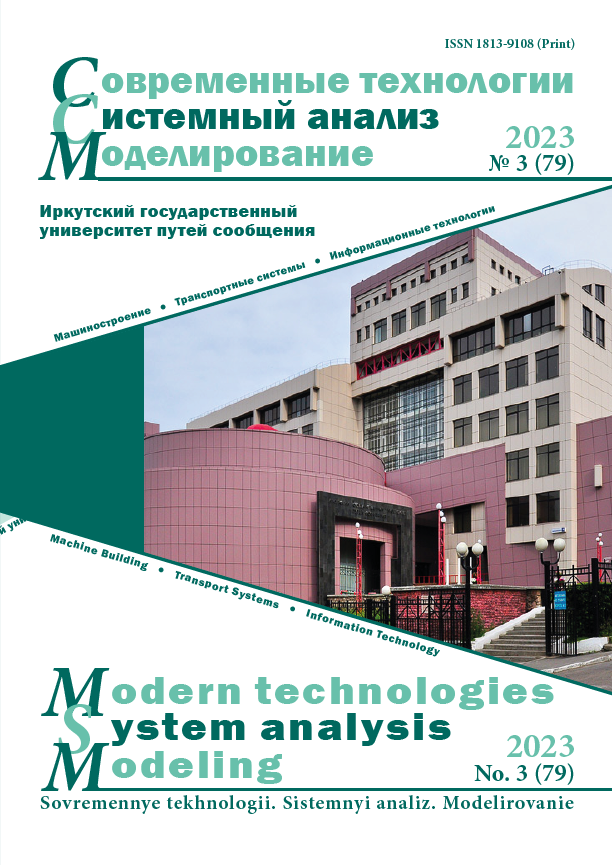Mathematical model of an induction machine with consideration of saturation and heating
Keywords:
induction machine, mathematical model, equivalent circuit scheme of induction machine, thermodynamic model, computer modelingAbstract
The article discusses the methodology of development of a mathematical model of an asynchronous electric motor. The analysis of some disadvantages of such models, based on an equivalent T-shaped circuit scheme, is carried out. Among these are not always applicable interface variables (input signals), as well as neglect for core magnetization and losses in steel. Dealing with these drawbacks significantly expands the application area of the models considered allowing, in particular, to use them in asynchronous drive control systems based on a sensorless control method. This approach includes no physical sensors of temperature and rotor speed, the signals from which are calculated by indirect parameters. In this regard, it is necessary to take into account nonlinear processes, which increases the accuracy of the calculation. It is shown that among the existing methods of considering of the magnetization, the method of static inductances is preferable. It represents the mutual inductance between the stator and the rotor as a dependency on magnetizing current. The introduction of this dependence will not make the model nonlinear, but it gives a more correct calculation with a minimum of additional parameters. At the same time, losses in steel are accounted for by introducing an active resistance in parallel to the magnetization circuit. This paper provides a detailed description of the development of the model with a theoretical justification for the use of certain assumptions and equations. The input variables of the model are limited by three phase voltages, the speed of rotation of the rotor and the temperature of the outside air. This set can be considered the minimum necessary for using the model as part of a frequency asynchronous drive control system. Such control systems are most sensitive to the resistance of the stator winding of the electric motor. Therefore, a method for calculating its temperature is proposed based on a two-mass model that considers an electric motor in the form of two parts: windings and a core with a casing. At the end of the work, the calculation of the parameters of the equivalent substitution circuit is given on the example of a specific electric motor with the results of its modeling.
References
Асинхронный тяговый привод локомотивов / А.А. Андрющенко, Ю.В. Бабков, А.А. Зарифьян и др. М. : УМЦ по обра-зованию на ж.-д. трансп., 2014. 412 с.
Increasing the Performance of Electric Traction in the Long Term on the Next-Generation Technological Horizon / A.T. Burkov, A.N. Marikin, A.V. Mizintsev et al. // Russian Electrical Engineering. 2018. Vol. 89, № 10. P. 588–591.
Ronanki D., Singh S.A., Williamson S.S. Comprehensive Topological Overview of Rolling Stock Architectures and Recent Trends in Electric Railway Traction Systems // IEEE Transactions on Transportation Electrification. 2017. Vol. 3. Iss. 3. P. 724–738.
Blasco-Gimenez R. High Performance Sensorless Vector Control of Induction Motor Drives. Nottingham : University of Not-tingham, 1995. 269 p. DOI :10.1109/TTE.2017.2703583.
Korkmaz F. Performance improvement of induction motor drives with model-based predictive torque control // Turkish Journal of Electrical Engineering and Computer Sciences. 2020. Vol. 28. No 1. P. 525–539.
Bose B.K. Modern power electronics & AC drives. Upper Saddle River : Prentice Hall, 2002. 738 p.
Фролов Ю.М. Электрический привод. СПб. : Лань, 2021. 236 с.
Солодкий Е.М., Сальников С.В., Даденков Д.А. Диагностика межвиткового замыкания обмотки статора асинхронного двигателя на основе анализа траектории вращения вектора тока статора // Вестн. ПНИПУ. Электротехника, информационные технологии, системы управления. 2020. № 34. С. 114–127.
Вейнреб К. Диагностика неисправностей ротора асинхронного двигателя методом спектрального анализа токов статора // Электричество. 2012. № 7. С. 51–57.
Рогачев В.А. Диагностирование эксцентриситета ротора асинхронных электродвигателей по гармоническому составу тока статора : автореф. дис. … канд. техн. наук. Новочеркасск, 2008. 19 с.
Киселев И.Г., Курилкин Д.Н., Шрайбер М.А. Тепловая модель асинхронного тягового электродвигателя тепловоза // Изв. Петербург. ун-та путей сообщ. 2021. Т. 18. № 4. С. 460–468.
Дорощенко И.В., Погуляев М.Н. Имитационная модель асинхронной машины с фазным ротором в MATLAB Simulink // Вестн. Гомел. гос. техн. ун-та им. П.О. Сухого. 2021. № 2 (85). С. 99–106.
Макаров В.Г. Асинхронный электропривод с оптимальными режимами работы. Казань : Казан. гос. технолог. ун-т, 2010. 299 с.
Копылов И.П. Математическое моделирование электрических машин. М. : Высш. шк., 2001. 327 с.
Ratnani Punit L., Thosar A.G. Mathematical Modelling of an 3 Phase Induction Motor Using MATLAB/Simulink // International journal of scientific research in science, engineering and technology. 2014. Vol. 4. Iss. 6. P. 137–141.
Шенделёв М.А. Асинхронный частотно-регулируемый электропривод испытательного стенда : магистер. дис. Томск, 2018. 138 c.
Усольцев А.А., Лукичёв Д.В. Определение параметров модели асинхронного двигателя по справочным данным // Изв. высш. учеб. завед. Приборостроение. 2008. Т. 51, № 10. С. 35–41.
Лихачев В.Л. Электродвигатели асинхронные. М. : Солон-Р, 2002. 304 с.
Калачев Ю.Н. Векторное регулирование (заметки практика). М. : ЭФО, 2013. 72 с.


